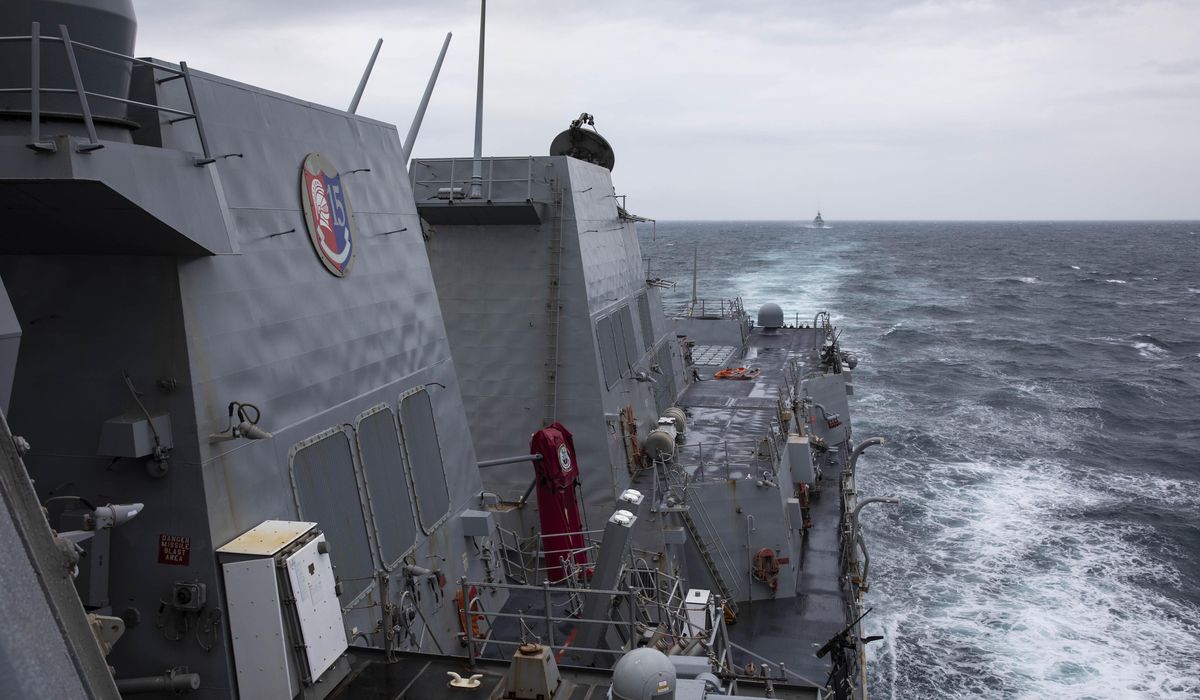

Two recent encounters between a Navy guided missile destroyer and two People’s Liberation Army warships in the South China Sea were safe, legal, and not provocative, according to a statement from the Navy’s Pacific Fleet that seeks to rebut accusations from Chinese defense officials.
PLA Sr. Col. Wu Qian, a spokesman for the Defense Ministry, said Thursday in Beijing that the destroyer USS Ralph Johnson on Aug. 19 sailed too close to the PLA destroyer Guilin and the frigate Huangshan near the Paracels Islands. The PLA released video of what Col. Wu said was the USS Ralph Johnson making unsafe maneuvers near both ships.
“This video proves that it is the U.S. side that is making provocations, taking risks and muddling the water,” he said.
But a review of the video, U.S. officials said, shows the American destroyer sailed a safe distance in front of the Guilin and passed about a mile away from the Huangshan.
A spokeswoman for the Pacific Fleet denied the PLA characterizations and said in a statement to The Washington Times that all interactions during the summer encounter were safe.
“The People’s Republic of China (PRC) claims that the Aug. 19 interaction with USS Ralph Johnson was unsafe are inaccurate,” the statement said, contending that the American destroyer operated at all times in compliance with international law and under the terms of the Convention on the International Regulations for Preventing Collisions at Sea (COLREGS) and the Code for Unplanned Encounters at Sea.
“The video released by the PRC only shows cropped segments of a 90-minute interaction between multiple [PLA navy] ships and USS Ralph Johnson,” the statement said.
“Importantly, this interaction occurred beyond the territorial waters of any nation where international law preserves high seas freedoms of navigation and overflight.”
“While protecting high seas freedoms of navigation for all nations, USS Ralph Johnson operated in a lawful, safe and resolute manner,” the Pacific Fleet said. “The United States will continue to fly, sail and operate wherever international law allows in order to safeguard a free and open Indo-Pacific.”
David Stilwell, a former assistant secretary of state for East Asia and Pacific affairs, said the Pacific Fleet rebuttal was a welcome change from past U.S. military passivity toward Chinese propaganda.
“It looks like the PRC propaganda machine has finally met its match; they’ve exhausted their credibility,” Mr. Stilwell said. “In the past we would self-censor and allow Beijing to own the narrative. The Biden ‘Assertive Transparency’ concept is welcome; keep it coming. And release the balloon photos while you’re at it.”
Mr. Stilwell was referring to the Biden administration’s refusal to make public detailed photographs of recovered electronic spying gear from a Chinese balloon that was shot down off South Carloina’s Atlantic coast in February after flying across much of the continental U.S..
Col. Wu made the comments during a ministry press conference when asked about recent Pentagon criticism of dangerous PLA aerial intercepts of U.S. and allied aircraft.
The PLA has additional videos but declined to release them at the time because of time constraints, he said.
His comments came in response to remarks last week by Adm. John Aquilino, commander of the Indo-Pacific command, and Ely Ratner, assistant defense secretary for Indo-Pacific security affairs, who released videos and information showing what they said was a major PLA campaign to harass U.S. and allied surveillance aircraft operating in international airspace near China.
Mr. Ratner and Adm. Aquilino said there were 180 unsafe encounters between Chinese jets and U.S. aircraft just in the past two years.
The officials warned that some of the intercepts were dangerous and could have led to the deaths of air crews or set off an unintended conflict.
China responded to the criticism on Tuesday by conducting what the Indo-Pacific command said was another dangerous nighttime intercept of a B-52 bomber flying over the South China Sea.
